As it has been a privilege and pleasure for so many years to contribute to the Handbook there is not really anything new for me to write about; but in the last twenty years so many new and successful exhibitors have come into the Breed, and as Mrs. Gray's first book on the Welsh Corgi is no longer available (indeed it looks like becoming a valuable heirloom in those families fortunate enough to own a copy), I think perhaps members may like to get some of the impressions I gained of what it was like before the war. Any dates are taken either from Mrs. Gray's book or from the League Handbooks which contain the History of the Breed since the war.
Pre-war Championship Shows nearly always lasted two days. On the first you exhibited, but apart from some Obedience Classes I'm not very clear on what happened on the second day, but if you were new to the game, it was very dull, because nobody spoke to anyone they didn't know. I think this would not happen now as people are much more matey and no newcomer need feel as isolated as you could do in the old days.
At Crufts puppies didn't have to go back for the second day but adult dogs had to stay overnight unless their kind-hearted owners paid a guinea to take them out. They were however refunded 1 £ when they turned up for the second day. I think this rule must have brought in a good many shillings profit!!! Think of some big fierce dog breaking its chain and playing havoc among all the little captives on the benches!!!
After the war when petrol was scarce it was a frightening sight to look into the Guard's Van on a night train bound for a Northern Show, big dogs chained all round the edges and how thankful I was that my corgi was safe in his travelling box.
I can remember one Championship Show with an unpopular All Rounder judge where all the well-known exhibitors entered their best dogs "NOT FOR COMPETITION", to show their disapproval. Also, another when everyone had a good idea who was going to get the C.C. The exhibit in question came into the ring going "dot and carry one" and though the judge certainly seemed to favour him the ringside stood up and shouted, "You can't put up a lame dog", and he couldn't and didn't after all!!!!
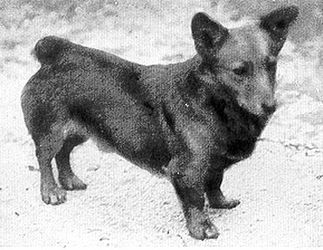
Ch. Bowhit Pepper |
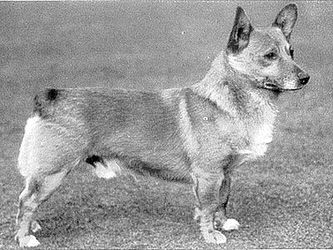
Ch. Crymmych President |
The Welsh Corgi Club, the pioneer club of the Breed was founded in 1925 at which time the breed was unknown in the Principality, except in Pembrokeshire and Cardiganshire. This club was followed by the The Welsh Corgi League in 1938, which held its first show at Tattersalls in 1939. Ch. Bowhit Pepper seems to have been the first Champion, born 1926. Ch. Crymmych President was born in 1929 and his son Ch. Rozavel Red Dragon born 1932 seems to have been the dog that really started things off, and I doubt if there are any corgis today which are not descended from him. I think it is to him, plus of course the fact that the then Duke of York bought a Corgi from Mrs. Gay in 1933 for his daughter our present Queen Elizabeth, that started the breed on its giddy spiral of popularity 'till it reached the heights of being second in the Kennel Club numbers of registrations in 1960.
Dragon mated only about 100 bitches and these in those days must have been all sorts and shapes, but he managed to stamp his offspring with his own essential type and quality, combined with a glamour which none of the other stud dogs of that day achieved. I remember once going to a show with a non-doggy friend and he called me over to see "a real bonny one" he'd found, and of course it was Dragon.
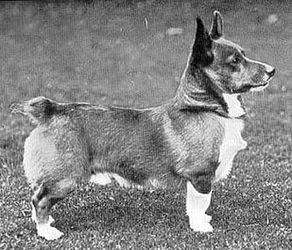
Ch. Rozavel Red Dragon |
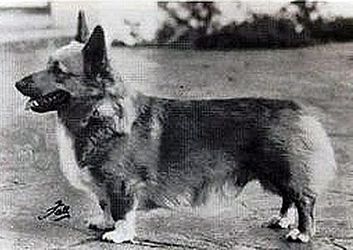
Ch. Maracas Masterpiece |
He sired 13 Champions, the greatest record for a Corgi, although later Champions must have mated many more bitches. The feat is only approached by Ch. Maracas Masterpiece, sire of 11 Champions. I think the next best sire was Ch. Teekays Felcourt Supremacy, who sired six champions, all bitches. I cannot remember any other dog having sired more than four Champions.
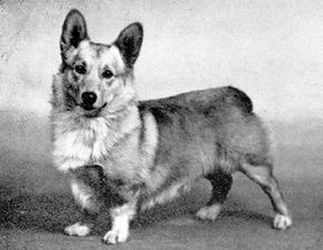
Ch. Rozavel Lucky Strike |
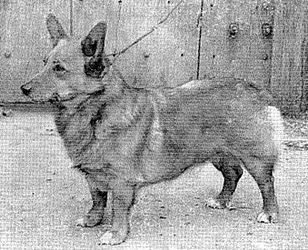
Ch. Rozavel Scarlet Emperor |
Dragon was a gorgeous bright scarlet, with flashy white socks and chest. I still think his photo compares favourably with many of today's top winners. There was no exaggeration anywhere. He was a natural bob tail as was his last Champion son, Rozavel Lucky Strike. In July 1931 the Kennel Club ruled the Pembrokes could not be docked, and only natural bob tails could be shown, but in September 1934 this rule was rescinded, following the granting of separate registrations for Cardigans. Prior to this the two breeds had been shown as Any Variety Welsh Corgi.
Dragon's son, Ch. Rozavel Scarlet Emperor was also a pillar of the breed, tho' Mr. Sonley, who was for many years Mrs. Gray's kennelman told me that he thought Ch. Cadno Coch of Cleddau , another son of Dragon, to be a better dog, but he was very little used by breeders.
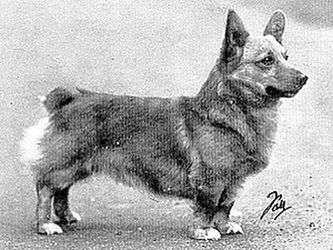
Ch. Teekays Felcourt Supremacy |
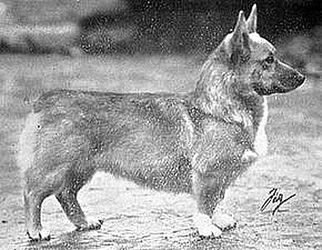
Ch. Lees Coronet |
Descended from Emperor we get Ch. Teekays Felcourt Supremacy, sire as I said before of six bitch Champions. I would not have called him an outstanding Champion but he certainly was an outstanding sire and Ch. Maracas Masterpiece was descended from his most outstanding daughter, Ch. Lees Coronet. Where Supremacy scored was in handing on his showmanship and good bone which had deteriorated during the war years when shows were restricted to a radius of 25 miles, and consequently the quality of the entry could be very poor. I don't think Supremacy ever sired a really good dog, but one of his sons sired Ch. Knowland Clipper, which held the record number of C.C.'s 'till beaten by his own son Ch. Zephyr of Brome, and Clipper was also the top of the stud dog list for three of four years.
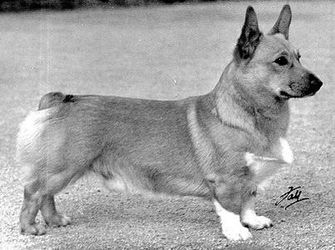
Ch. Knowland Clipper |
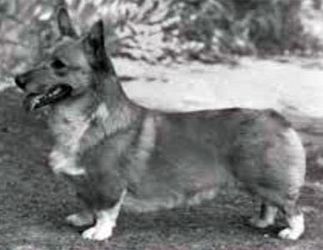
Ch. Zephyr of Brome |
Since Masterpiece we have had no outstanding stud dog which can fill rings with a preponderance of winners, although we have had dogs which can get the odd outstanding Corgi. Nowadays of course we have the choice of many more stud dogs and Masterpiece had the advantage of being sired by Ch. Lees Symphony, one of a litter of three Champions. Symphony left for the U.S.A. at just a year old, so it was fortunate that Masterpiece, whose litter sister Ch. Kaytop Maracas Mist won R.B.I.S. at Crufts, stayed to carry on the good work in this country.
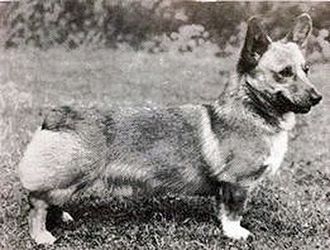
Ch. Lees Symphony |
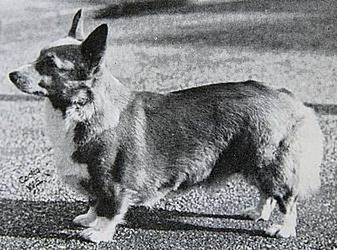
Ch. Kaytop Maracas Mist |
One of the things we never seem able to standardise in Corgis appears to be size. I say size deliberately, and I do not mean weight, because two dogs of about the same size with apparently the same bone and body can vary from each other up to two or three pounds. Mrs. Gray lists in in her book the weights of six Champion dogs and six Champion bitches. The heaviest dog is 24½ lbs., the lightest 17 lbs. The heaviest bitch 32 lbs., the lightest 20 lbs.
When I came into the breed in 1936 the Corgi was a handy sized dog, but latterly the accent has been on length and bone. Immediately after the war there was such a revulsion against the spindly types that had been winning at radius shows, that good bone became the criterion. With the result that we got many heavy heads and bad feet. Today registrations have dropped from 8,933 in 1960 to 4,459 in 1967. In Sir Richard Glyn's book, Champions of the World, he writes that the Field Spaniel has practically disappeared, as it was bred so long, low and heavy, that it almost needed a third pair of legs in the middle.
The Corgi is a medium sized dog. It has teeth and bone as big as an Elkhound, which tho' not classed as a big breed is still a sizeable dog. When people come to buy pets they always stress that they don't want a big one and the small ones of the litter are always the first to go. No breed can stay "Top of the Pops" for ever, Poodles and Beagles have come up since the war, but the pet market matters tremendously to most breeders. With living space diminishing the smaller dog is going to be more in demand than the big one. Corgi intelligence and hardiness endear the breed to everyone who has ever owned one. I hope the registrations will rise again.
B.M. Morgan
The Welsh Corgi League Handbook 1968
06.03.2023
